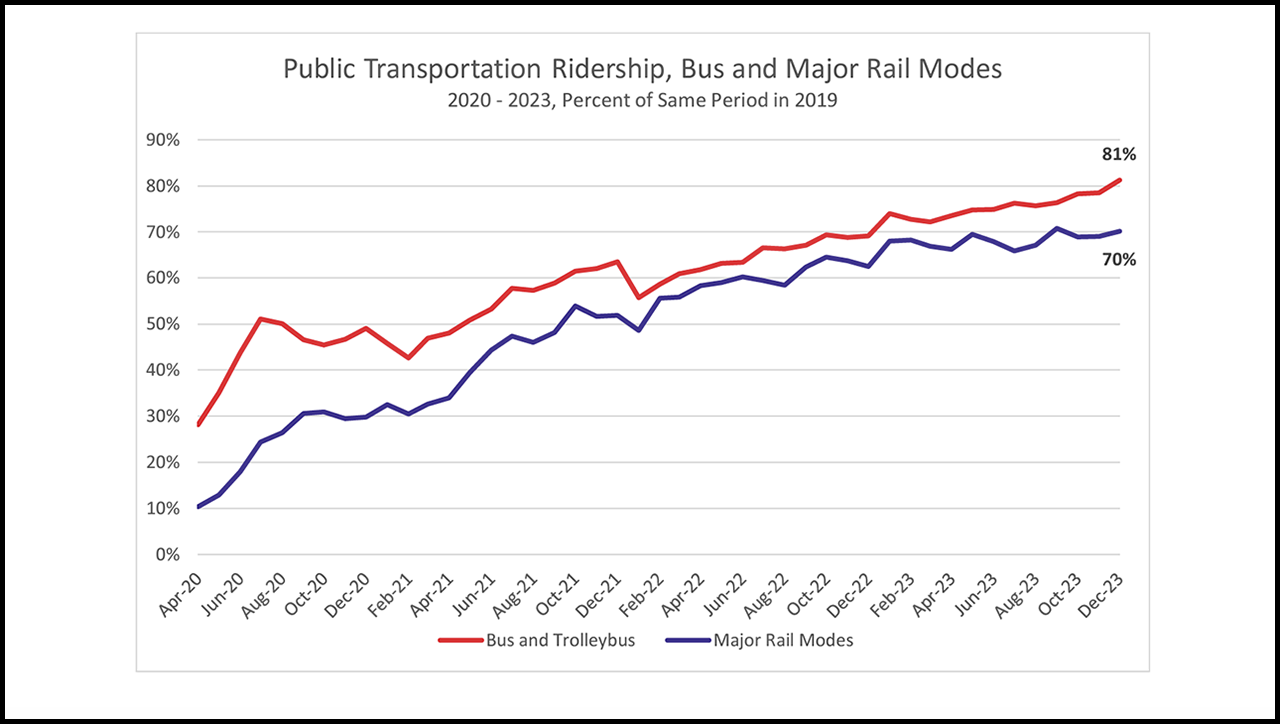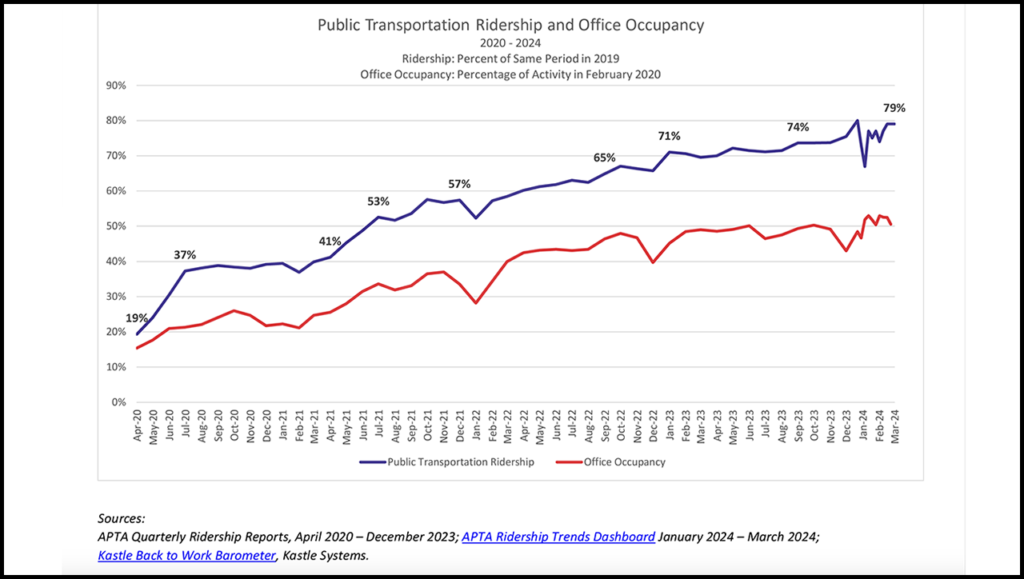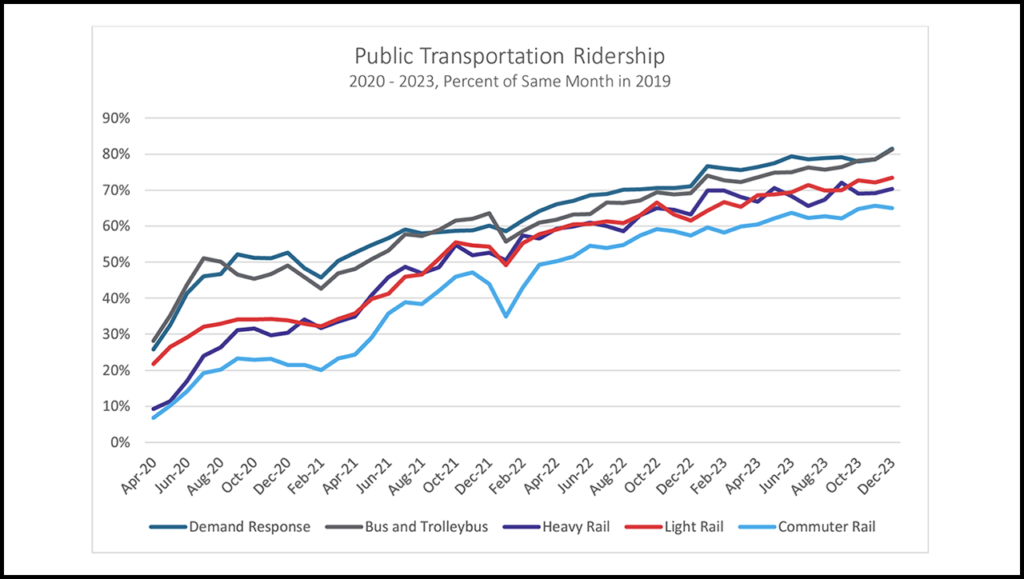
APTA Releases Ridership Trends Report
Written by Marybeth Luczak, Executive Editor
During 2023, rail ridership grew by eight percentage points relative to 2019 (pre-pandemic) levels, ending the year at 70%, while bus ridership grew by 12 percentage points to 81% of 2019 levels, according to the latest APTA report. (Chart Courtesy of APTA)
After falling to 20% of pre-pandemic levels in April 2020, public transit has recovered to 79% of pre-pandemic levels as of March 2024, according to the American Public Transportation Association’s (APTA) latest ridership trends report.
Among the report’s other main findings:
- Transit riders took 7.1 billion trips on public transit in 2023, a 16% increase over 2022.
- Public transportation ridership levels increased throughout 2023, while office occupancy rates remained stagnant.
- During 2023, rail ridership grew by eight percentage points relative to 2019 (pre-pandemic) levels, ending the year at 70%, while bus ridership grew by 12 percentage points to 81% of 2019 levels.
- Demand Response and Bus have recovered the most ridership, reaching 81% of pre-pandemic levels in December 2023. Heavy and Light Rail reached 70% and 73% of 2019 ridership levels, respectively, and Commuter Rail reached 65% of pre-pandemic levels as of December 2023.
Following are highlights from the April 1, 2024, APTA Public Transportation Ridership Update report (download below), covering the national ridership picture, trends, modal differences, and what transit agency practices are leading to ridership success.
National Ridership Picture
“Return-to-office policies and a strong job market both have positive implications for public transportation ridership recovery,” according to the APTA report. “However, office occupancy rates remained flat at 50% throughout 2023, according to Kastle Systems. Regardless of slow office occupancy recovery, public transit ridership recovery has continued. This recovery indicates that transit agencies are having success in attracting non-commute trips. Current data remains limited, but indicators in several metro regions point to transit recovery being led by trips to and from residential and commercial areas as opposed to office/work centers. More time and data are needed to determine if this transit demand shift will remain the driving force for ridership return.”
According to APTA, the structure and makeup of local economies also impact the degree of transit ridership decline. “Technology-focused economies with an existing and prominent work-from-home culture initially noticed a steeper decline in ridership than those with more service industry jobs and essential workers who power the supply chain,” the association reported. “Systems in college towns were also severely affected, as many universities closed and sent students home. Regions of the country that were hardest hit early in the pandemic (e.g., the Northeast, Seattle, and San Francisco Bay areas) had, in general, larger ridership drops than other areas of the country that saw the worst pandemic impacts later in 2020. Bus ridership recovery has been the consistent leader compared to other transit modes largely due to bus rider demographics. According to APTA’s Who Rides Public Transportation [report], 22% of bus riders are under the age of 25, twice the percentage of younger rail riders. With bus riders on average earning less than rail riders and often working non-office jobs, they have been a critical driver of ridership recovery for many public transit agencies. Regional differences in modal ridership return have presented themselves. Generally, Bus and Demand Response have led the way followed by Heavy/Light Rail and Commuter Rail trailing. However, some regions have bucked that trend. For instance, at the Massachusetts Bay Transportation Authority in the Boston area, Commuter Rail ridership return leads Heavy and Light Rail ridership return.”
APTA noted that ridership “tracked closely with job growth generally, and service industry jobs more specifically.” The cost of owning a car, it reported, provides further insight. A recent APTA analysis shows that riders can save more than $13,000 annually by using public transit instead of driving.
As of January 2023, national public transit ridership was at 71% of 2019 levels, according to APTA. In September 2023, ridership rose to 74% of 2019 levels, it reported, and remained at that level through the end of 2023. Public transit ridership rose 16% from 2022 to 2023, to 7.1 billion total trips in 2023. In the first three months of 2024, APTA said that its Ridership Trends Dashboard shows that U.S. public transportation ridership has fluctuated between 73% and 79% of 2019 levels, when comparing the same week in each year.
Important Trends
According to APTA, data from its Quarterly Ridership Report indicates that ridership recovery has differed based on city size. “In general, smaller cities have recovered ridership to a higher level than larger cities,” the association reported. “The largest urban areas (population more than 2 million) and medium-sized urban areas (population 500,000 to 2 million) have recovered ridership to approximately the same level when compared to 2019. In general, smaller cities tend to serve relatively fewer riders with alternatives such as teleworking. Office return data also suggests that proportionally more workers in smaller cities are working in offices than in larger cities. The data from medium-sized urban areas suggest that those areas have had particular difficulty attracting office workers and those with more options back to transit.”
In fourth-quarter 2023, smaller cities (population 100,000 to 500,000) recovered to 79% of 2019 transit ridership levels, and the largest and medium-sized urban areas recovered to 74%, data from APTA’s Quarterly Ridership Report shows.

Modal Differences
“Although all public transit modes saw significant decreases in ridership because of the COVID-19 pandemic, rail modes (i.e., heavy rail, light rail, streetcar, commuter rail, and hybrid rail) had comparatively larger decreases compared to bus modes,” according to the APTA report. Rail ridership during the early part of the pandemic dropped to 10% of pre-pandemic levels in April 2020, the report found, while bus ridership decreased to 28% of pre-pandemic levels. “In general, bus modes have been able to retain more riders than rail modes because they generally serve more essential workers, while rail modes serve more office commuters,” according to APTA. “During the pandemic, rail riders have been more likely to have options to work from home.”
During 2023, rail ridership grew by eight percentage points relative to 2019 levels, ending the year at 70%, while bus ridership grew by 12 percentage points to 81% of 2019 levels.
Looking at individual modes, the APTA report shows that Demand Response and Bus have recovered the most ridership, reaching 81% of pre-pandemic levels in December 2023 (see chart below). Heavy and Light Rail reached 70% and 73% of 2019 (pre-pandemic) ridership levels, respectively, and Commuter Rail reached 65% of pre-pandemic levels as of December 2023.

“Commuter rail historically has seen increased ridership with high gas prices, but the spring and summer gas price increases did not drive an increase in ridership,” according to the APTA report. “Of note, regions with the highest gas prices are also the ones with the most extensive commuter rail systems impacting regional ridership return.”
What Leads to Ridership Success
According to APTA, its On the Horizon: Planning for Post-Pandemic Travel report collected best practices on transit ridership successes. It found that agencies retaining ridership made sure to:
- Consistently communicate with the public, “keeping them abreast of changes to public transit service.”
- Conduct “reinforcing” social media campaigns.
- Monitor customer feedback.
- “Think proactively about service, focusing on essential workers and social equity, communities of color, and low-income families,” according to APTA.
- Emphasize rider and employee safety. “Sanitation measures implemented by many transit agencies with more routine cleaning protected riders and provided greater feelings of safety,” according to APTA.
- Focus efforts on historically marginalized communities. “Rebuilding post-COVID provides a unique opportunity for reinvestment in equitable transit,” according to APTA. “Investing in transit operations to better support hourly, late-night, and early-morning workers who rely on public transit would further equity goals by providing transit choices for at-risk residents. With investments in communities of low income and otherwise vulnerable people, public transit agencies can regain lost ridership and support the larger community.”
Additionally, APTA said that real estate investment in central-city areas, in partnership with transit agencies, “will potentially further support increased ridership. Development of affordable and market-priced housing in proximity to transit routes will serve to benefit all community residents, including transit riders.”
“Success in ridership recovery has been dependent on transit service delivery and reliability and external factors, such as the makeup of local economies,” APTA President and CEO Paul P. Skoutelas said. “As clearly illustrated during the pandemic, public transportation provides mobility to essential workers, which has sustained transit ridership over the past four years. Public transit agencies continue to develop innovative solutions that are powering this ridership recover.”



